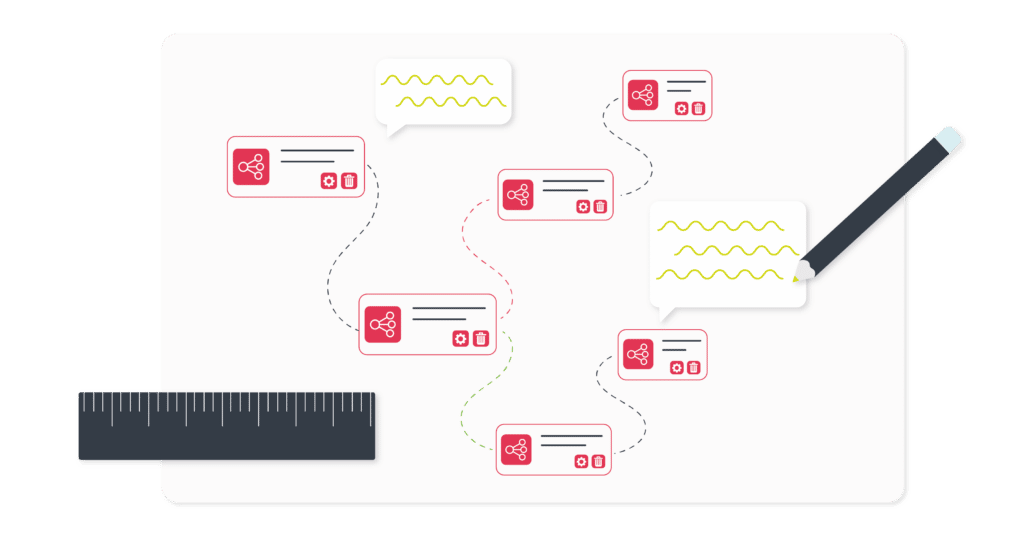
Updated on by Hayley Brown
You’ve come to the conclusion that you need integrations to grow your business and product to increase customer satisfaction.
There are multiple options for integrations. This could be delivering them in-house, which would mean building from scratch and writing a lot of code to achieve each individual integration. They could also be delivered by a third party, which means outsourcing integrations to be achieved off-platform with the likes of Zapier. Lastly, they could be designed using an iPaaS platform such as Cyclr. This iPaaS platform will be embedded into your platform and invisible to your end-users.
No matter how you decide to implement integrations there are a number of best practices you’ll need to follow to ensure success.
Communication
Communication is key across all stakeholders when building and implementing integrations.
It is important to understand the use case you are building the integration for and it is well communicated to and from the end user. If you have preexisting SaaS integrations with other third-party applications then you’ll already understand how users interact with the application and the data inside.
This would mean selecting what data is needed for the integration to access. As well as how to attribute the records with the application. Then work out if the integration will be triggered via polling or an event-driven webhook.
This means that prior to building the integration request needs to be properly scoped.
Scoping Integrations
The key to creating a successful integration more often than not hinges on its original definition.
On the face of it, this should seem like a simple enough task. However, high-level requirements miss the low-level detail required to create a fully optimised integration. This is why properly scoping an integration is important.
For instance, an integration request may identify a need for integration between the host application and in this example Zendesk. This request is the lowest level of a request because it offers little insight into what they want to integrate.
On the other hand, if the integration request says something to this effect, “I want to create a new ticket in Zendesk when a deal reaches a certain stage.” It builds upon the previous type of request and offers more detail in order to perform a bespoke task.
Scope and communication are two important practices when building integrations and are vitally useful to know prior to the planning stage.

Planning Integrations
Prior to any integration project, it is important to plan ahead to what you want to achieve, especially if it is a customer request. With SMART goals you’ll be able to create a realistic plan with specific, measurable, attainable, relevant and timely goals. This will mean attaining the results you were expecting.
As well as setting realistic goals you’ll need to define the scope of the integration project. As well as the schedule for the work and cost. It is important to develop contingency plans and allow for some potential changes to the initial integration plan.
For instance, prior to building, you should ask what would be best, a library of many but small functional integration workflows. Or fewer large workflows that cover several stages of a process. This is ultimately influenced by the specific use case.
At Cyclr we have found that creating a wider range of focused integration workflows is better.
While this may mean that your users have to install more integrations to do what they want, this approach can offer advantages such as enhanced integration management which means easier to bug-fix and update. As well as wider adoption because some customers only want to use a small part of the integration, so being able to pick and choose allows them to create their own automation stack.
Designing Integrations
It is important to design integration solutions with the business goals of your stakeholders in mind. In other words, make sure you’ve scoped the integration request and understand the use case. As it will directly help and benefit a stakeholder’s business goals.
It can be incredibly helpful to sketch out the integration process you are aiming to automate. By roughly designing the process it’ll help visualise laying up your integration and what to consider as the next steps in the process.
As well as identify the data sources, logic and data orchestration and objectives. This can make the world of difference when it comes to building efficient and resilient integrations.

Identification
No two SaaS applications are the same and each has its own particularities. This can result in inconsistencies when making assumptions about the API capabilities of applications in the same vertical markets. For instance, Salesforce and HubSpot.
One application can complete a task or tasks using the polling method, such as ‘Get New Contact’. Whereas the other platform may offer the same but through an event-triggered webhook. This is a subtle difference but it can affect the choices made when designing the integration workflow.
Within Cyclr users can check what methods are available for each Connector. If the method you need isn’t listed get in touch and our Connector Team are happy to build out the capability for you.
Experience
The experience of deploying self-service integrations is important for your end-users. This can also have an impact on the types of integrations you create.
It is important because users are going to have input in regard to setting up the integration. This could be authenticating a service, selecting a data source or defining a logic step for data manipulation and orchestration. This input will transform a templated integration into a value business automated resource.

For instance, we have made this a flexible option within Cyclr as you can either build your own UI on top of our API. Alternatively, you can use our white-label embedded marketplace. The marketplace gives users the ability to self-serve integrations to end-users directly inside your SaaS. With your own branding, you’ll be able to present hundreds of integration possibilities to your end-users who can quickly and efficiently deploy with minimal developer involvement.
Another way to enhance the experience for your users is to pre-map fields. This can be done for any field when you know the required data is coming from the same data source.
In Cyclr you can achieve this by first, selecting the source, this can be any step used in your integration template. This is to the left of the step you are configuring fields for. Then select the field within it to pre-map it.
Conclusion
We encourage an 80:20 rule when approaching integrations and an embedded iPaaS is one way to enhance your integration capabilities and leverage your growth as a business.
Get in touch with a member of our team or take a look around our integration platform in a free trial.



